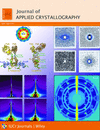issue contents
Small-angle scattering special issue (December 2016)
Guest editors: Michael Gradzielski and Andrew J. Allen
Guest co-editor: Andrew Jackson
The articles in this virtual special issue of Journal of Applied Crystallography represent some highlights of the 16th International Conference on Small-Angle Scattering (SAS2015). The issue brings together articles originally published in the journal between October and December 2016.

Cover illustration: Some highlights from SAS2015. Images courtesy of Perkins et al. [J. Appl. Cryst. (2016), 49, 1861–1875], Kaneko et al. [J. Appl. Cryst. (2016), 49, 1420–1427], Lehmkühler et al. [J. Appl. Cryst. (2016), 49, 2046–2052] and Karlušić et al. [J. Appl. Cryst. (2016), 49, 1704–1712].
Open  access
access
 access
accessThis open-access collection of 11 selected articles covers a small but quite diverse and interesting part of the much wider range of scientific topics presented at the 16th International Conference on Small-Angle Scattering (SAS2015) in Berlin. The topics contained here describe the particular directions in which small-angle scattering is developing at the current moment and which will become increasingly important in the future. The virtual special issue is available at //journals.iucr.org/special_issues/2016/sas2015/.
Open  access
access
 access
accessAn X-ray cross-correlation study with emphasis on colloidal crystals is presented and demonstrates how to access higher-order structure beyond pair correlations. In this way symmetries of the crystal can be determined that are inaccessible in conventional crystallography.
Open  access
access
 access
accessThe CCP-SAS project is currently developing software for the atomistic and coarse-grained molecular modelling of X-ray and neutron small-angle scattering data. Its computational framework is described, alongside applications in biology and soft matter.
Open  access
access
 access
accessA technique for the analysis of magnetic scattering has been developed, where small-angle neutron scattering and Bragg edge transmission measurements are performed simultaneously. This technique is shown to provide crystallographic information for ferrite crystallites and nanostructural information for precipitates in steel.
Open  access
access
 access
accessContrast variation small-angle neutron scattering by dynamic nuclear polarization is applied to industrial multi-component nanocomposites.
Open  access
access
 access
accessThree-component fluids can exhibit structured density fluctuations, and their small-angle scattering patterns present similarities to those of classical microemulsions. One general analytical expression with two additive contributions (one for the two immiscible fluids and a smaller one for a structured fluid) allows the whole phase diagram to be mapped in the single-phase domain.
Open  access
access
 access
accessA combination of small- and ultra-small-angle X-ray scattering enabled the resolution of important intracellular constituents in Escherichia coli (ribosomes, DNA and proteins). The impact of treatment with three antibiotic agents was monitored.
Open  access
access
 access
accessA new simultaneous measurement method combining small-angle neutron scattering and Fourier-transform infrared spectroscopy was applied to a study on a syndiotactic polystyrene cocrystal with polyethylene glycol dimethyl ether with a molecular weight of 500. It is suggested that the guest molecules in the crystalline region have an elongated structure along the thickness direction of the crystalline lamellae.
Open  access
access
 access
accessThis publication describes the combination of size exclusion chromatography with small-angle neutron scattering in situ. The need for this technique and the progress achieved thanks to it are illustrated by relevant examples.
Open  access
access
 access
accessA new biological small-angle X-ray scattering beamline (BioSAXS, BL19U2) at the Shanghai Synchrotron Radiation Facility (SSRF) is dedicated exclusively to small-angle scattering experiments from biological macromolecules in solution. As part of the important facilities in the National Center for Protein Sciences Shanghai (NCPSS), this BioSAXS beamline is the first in China to serve the rapidly increasing biology communities.
Open  access
access
 access
accessThe shape and sorption behaviour of pores in mesoporous ordered silica films are determined from grazing-incidence small-angle X-ray scattering data.
Open  access
access
 access
accessFormation of ion tracks on a rutile TiO2 (001) surface after exposure to swift heavy ions under grazing incidence is studied using atomic force microscopy, grazing-incidence small-angle X-ray scattering and in situ time-of-flight elastic recoil detection analysis.


 journal menu
journal menu




























